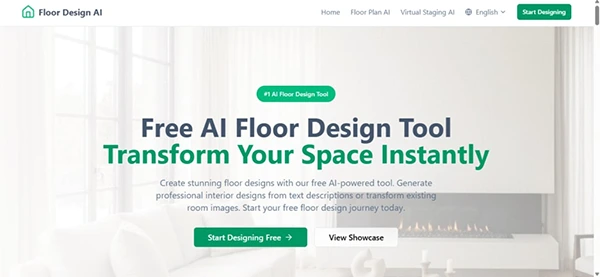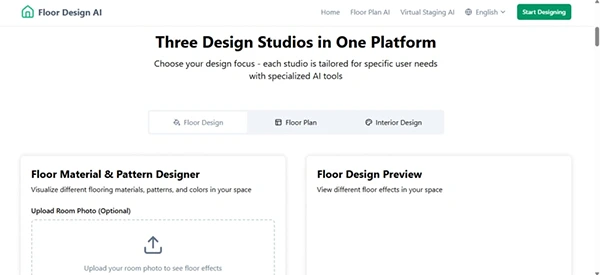From Sketch to Reality: How FloorDesign.ai Transforms Floor Plans Instantly
What is the typical duration you dedicate to creating a floor plan sketch? This significant disparity reflects the ongoing transformation within the field of design.
Throughout the years, architects and designers have relied on either traditional manual drawings or sophisticated CAD software to translate their concepts into functional layouts.
Although efficient, the old method required a lot of time, training, and investment. Generative AI applications such as Floor Design AI are taking the rules away today. Anyone, even homeowners or experts, can quickly see their vision come to life with just a sketch to upload or a description to type.
In comparison to the traditional solution, speed is not the only factor; accessibility, inventiveness, and cost-effectiveness are also important considerations. Through this blog post, we are going to explore more utilities of software.
Let’s begin!
Key Takeaways
- Understanding why designers struggle with AI tools
- Comparing FloorDesigns with conventional utilities
- Uncovering why it’s a smarter choice
Why Designers Struggled Before AI Floor Tools
Traditionally, floor planning has been designed using hand drawing and advanced computer-assisted design software. The methods were prohibitive to train, expensive to license, and labour-intensive to assemble. It took days to polish the designs by the architects, and homeowners could not see the process without professional help.
The high cost of the CAD software and the advanced interface posed a barrier to the ordinary man. More sophisticated designers could not cope with those cases when a client wished to alter something- hours of work were repeated. These pain points were determined by them: expense, delays, and inaccessibility. Design was beyond the reach of most people and the preserve of the professionals.
Also, teamwork was usually bulky. Sending large files to clients or team members to see the draft would have been required, feedback would have been awaited, and then changes would have had to be implemented manually. Experimentation was not an option; all the changes would take more labour hours and allow mistakes.
Interesting Facts
Based on market reports from 2024 and 2025, the AI interior design market is experiencing rapid expansion, with some analyses predicting the total market size could reach nearly $7.3 billion by 2033.
Comparing FloorDesign.ai With Old-School Tools

Traditional tools do not keep you down. In FloorDesign.ai, you will be able to test out several floor layout design free, experiment with materials, and design with others in real time. This is the future of floor planning, and it is available to anyone. FloorDesign.ai trial now and watch your ideas transform into reality.
Ease of Use
The conventional CAD software can take months to practice, whereas FloorDesign.ai can be used with a sketch or a brief text description. The user-friendly system is friendly to all users.
Speed
What once required hours—even days—can now be carried out within seconds. AI is able to generate fully laid-out images, saving time at each phase.
Cost
The CAD tools used by professionals can be costly and require licenses and expensive hardware. FloorDesign.ai is a free or cheap substitute and hence, affordable to everyone.
Accuracy
Whereas CAD tools are precise in a technical manner, FloorDesign.ai is creative with regard to accuracy. It is best used to visualize and design concepts and give presentations to clients, whereas CAD is necessary to provide details about engineering.
Accessibility
The usage of CAD is mostly limited to professional experts. FloorDesign.ai provides access to design to homeowners, students, and small businesses, making the connection between the idea and action.
Generative AI in Design: Faster, Smarter, More Accessible

Generative AI has transformed industries such as art and healthcare, and design is not an exception. AI capabilities of input analysis and learning based on large datasets, and producing realistic outputs, predetermine its application in floor planning.
AI spots basic sketches or text messages and translates them into refined, photorealistic designs within seconds. This transformation does away with the steep learning curves and democratizes design. This technology can help homeowners who are planning renovations, real estate agents who are staging homes, and interior designers who are trying out designs.
FloorDesign.ai uses AI to simplify creativity, which makes design easier as well as more interactive. In addition to speed, it is cost-reducing, enables fast iteration, and enables users with no professional background. With time and convenience being two of the factors considered nowadays, AI takes care of the fact that floor design is not lagging behind the current demands.
Feature Breakdown — What Makes FloorDesign.ai Different
Text-to-Design
Users are able to enter brief descriptions, such as an open-plan kitchen with an island and hardwood floors, and see AI create a layout of the same immediately.
Sketch-to-Design
Enter any rough sketch (or hand-drawing) and FloorDesign.ai will create an in-depth floor plan using realistic finishes.
Collaboration & Security
Teams are able to share, edit, and revise designs in real time. The platform has a high level of data security through encryption, backups, and compliance with GDPR.
Library of Materials
The built-in library can be completely customised, customising flooring textures, furniture models, and the like. The ability to experiment with various styles and finishes to attain high-quality results without any complications is an actual benefit of the tool.
Are you ready to Turn Your Ideas into Reality?
You do not have to waste hours of your life trying to create something with the help of a complex CAD program when you can make your dream come true in just a few seconds. FloorDesign.ai empowers you to create a photorealistic floor plan using just a sketch or a brief description without the steep learning curve.
It can be applied to both homeowners who are trying renovations, real estate professionals who are staging a house, and designers who want to quickly make many iterations of a design and make the work an enjoyable experience.
The visualization was also restricted, whereby the client would hardly envision the final layout out of the flat and technical drawings, and this would result in a misinterpretation and redefinition. All in all, the conventional way of floor planning was quite tedious, expensive, and unavailable to amateurs generally, which was a great deterrent to those wishing to actualize their designing concepts.
Ans: The utilities of AI tools help to leverage the power of machine learning and computer vision algorithms to automate the floor plan creation process.
Ans: Pre-programmed algorithms can struggle with highly specific client requests that fall outside standard parameters.
Ans: AI helps automate processes, generate design ideas, and offer solutions tailored to individual preferences.
